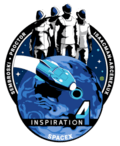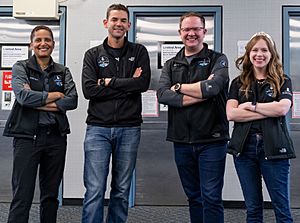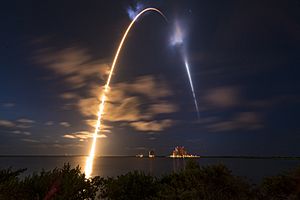Inspiration4 facts for kids

Launch of Inspiration4 on a Falcon 9
|
|
| Mission type | Private spaceflight |
|---|---|
| Operator | SpaceX |
| Mission duration |
|
| Spacecraft properties | |
| Spacecraft | Cargo Dragon C207 Resilience |
| Manufacturer | SpaceX |
| Launch mass | 12,519 kg (27,600 lb) |
| Landing mass | 9,616 kg (21,200 lb) |
| Crew | |
| Members |
|
| Start of mission | |
| Launch date | 16 September 2021, 00:02:56 UTC |
| Rocket | Falcon 9 Block 5 (B1062.3) |
| Launch site | Kennedy Space Center, LC-39A |
| Contractor | SpaceX |
| End of mission | |
| Recovered by | GO Searcher |
| Landing date | 18 September 2021, 23:06:49 UTC |
| Landing site | Atlantic Ocean |
| Orbital parameters | |
| Reference system | Geocentric orbit |
| Regime | Low Earth orbit |
| Altitude | 585 km (364 mi) |
| Inclination | 51.6° |
| Period | 96.2 minutes |
  Inspiration4 mission patches (SpaceX patch on right)  Proctor, Isaacman, Sembroski and Arceneaux |
|
Inspiration4 (also written as Inspirati④n) was a special space mission in 2021. It was run by SpaceX for Jared Isaacman, who is the CEO of a company called Shift4 Payments. The mission used a spacecraft called Resilience.
The Resilience spacecraft launched on September 16, 2021, at 12:02:56 AM UTC. It lifted off from Kennedy Space Center's Launch Complex 39A using a Falcon 9 rocket. The mission successfully sent the Dragon capsule into low Earth orbit (an orbit close to Earth). The journey ended well on September 18, 2021, at 11:06:49 PM UTC. The Resilience capsule landed safely in the Atlantic Ocean.
This mission was very important because it was the first time an orbital spaceflight had only private citizens on board. This means no professional astronauts from government space agencies were part of the crew. The mission was also a big effort to raise money for St. Jude Children's Research Hospital in Memphis, Tennessee. Jared Isaacman was the mission commander. St. Jude's hospital chose two crew members: Hayley Arceneaux and Christopher Sembroski. Shift4 Payments chose the pilot, Sian Proctor.
The Inspiration4 flight reached an altitude of about 585 kilometers (364 miles). This was the highest a human spaceflight had gone since 1999. To compare, the International Space Station orbits at about 408 kilometers (253 miles). The mission ended with the first crewed splashdown (landing in the ocean) in the Atlantic Ocean since 1969.
Contents
Mission Goals and Crew Members
Inspiration4 was the first space mission to orbit Earth with only private citizens. This means everyone on board was a regular person, not a government-trained astronaut. The main goal of the mission was to support and raise money for St. Jude Children's Research Hospital. The crew hoped to raise over $100 million for childhood cancer research at St. Jude's.
Jared Isaacman and his wife, Monica, personally gave $125 million to the hospital. Elon Musk, who founded SpaceX, also donated $55 million. With many other donations, the total amount raised for St. Jude's reached over $243 million. This was much more than they first aimed for!
Who Were the Crew?
The mission was led by Jared Isaacman, the CEO of Shift4 Payments. He is an experienced pilot who has flown military jets. Isaacman bought the flight and its four seats from SpaceX. He then gave two of the seats to St. Jude's hospital.
Hayley Arceneaux, a physician assistant at St. Jude's, was chosen by the hospital. She is also a survivor of bone cancer. St. Jude's held a raffle for the second seat as part of a fundraising campaign. People who entered the raffle had to be U.S. citizens and donate money. Kyle Hippchen won the raffle but gave his seat to his friend, Christopher Sembroski. Kyle was too heavy for the flight, and Christopher had also entered the raffle.
Sian Proctor, an entrepreneur, was chosen by Shift4 Payments. She won a competition similar to the TV show Shark Tank. In this contest, people presented business ideas that used Shift4's payment systems.
Resilience was the first spacecraft to orbit with a crew where everyone was flying to space for the first time since 2008. All four crew members got special training from SpaceX. This training included learning about how orbits work, how to live in microgravity (weightlessness), and what to do in emergencies. They also practiced the mission many times.
After the mission, it was reported that an alarm went off during the trip. This alarm was linked to a problem with the toilet on board.
| Position | Astronaut | |
|---|---|---|
| Mission Commander | First spaceflight |
|
| Pilot | First spaceflight |
|
| Mission Specialist 1 and Medical Officer | First spaceflight |
|
| Mission Specialist 2 | First spaceflight |
|
The Spacecraft: Resilience
The Inspiration4 mission used the Resilience spacecraft for its second flight. This was also the fourth time a Crew Dragon spacecraft carried people. For this mission, the part of the spacecraft normally used to connect to the International Space Station was changed.
Instead of a docking adapter, a special dome-shaped window was added. This window was inspired by the Cupola module on the International Space Station. It allowed the crew to have a 360-degree view of space from the front of the Resilience capsule. This window was protected during launch and when returning to Earth by the spacecraft's nosecone. The nosecone also held a camera to take pictures inside and outside the spacecraft.
The special window can be removed. This means Resilience can be changed back for future missions that need to connect to a space station. There are also four small engines called Draco thrusters on the spacecraft's nose. Special heat shield tiles were put on the window's outside to protect it from the heat of these engines when they fired.
The Flight Journey
The Resilience spacecraft launched on September 16, 2021, at 12:02:56 AM UTC. It was carried by a Falcon 9 Block 5 rocket from Kennedy Space Center's Launch Complex 39A. This was the third flight for this particular rocket booster. The spacecraft was launched into an inclination (angle of its orbit) of 51.6 degrees.
At one point, three Dragon spacecraft were orbiting Earth at the same time! This included Resilience, Endeavour (on the Crew-2 mission), and C208 (on the CRS-23 cargo mission). Inspiration4 was the first crewed orbital spaceflight since 2009 that did not visit a space station.
Each crew member had a special call sign for talking to mission control. Jared Isaacman's call sign was "Rook." Sian Proctor's was "Leo." Hayley Arceneaux's was "Nova," and Christopher Sembroski's was "Hanks."
Zero-G Indicator
As the second stage of the Falcon 9 rocket shut off, Hayley Arceneaux pulled out a small plush toy dog. This toy dog represents the therapy dogs used at St. Jude's. The toy, attached to a string, began to float above Hayley's head. This was its job as the Inspiration4 mission's "zero-g indicator." Seeing it float showed Hayley and her crewmates that they were now in the microgravity (weightlessness) of outer space. This happened after they reached Earth orbit on September 16, 2021.
The mission also included several health experiments. These studies looked at how spaceflight affects the bodies of regular people who are not professional astronauts. They measured things like fluid shifts, heart rates, and blood oxygen levels. This research was done with SpaceX and other medical research groups. As mentioned, an alarm did sound during the trip due to a toilet problem.
On September 18, 2021, at 11:06:49 PM UTC, Resilience landed in the Atlantic Ocean. A recovery ship called GO Searcher picked it up about 40 minutes later. Hayley Arceneaux was the first to leave the spacecraft, followed by Sian Proctor, Christopher Sembroski, and Jared Isaacman.
Orbital Height
The mission aimed to reach an altitude of at least 575 kilometers (357 miles). It actually reached 585 kilometers (364 miles). This was the highest a crewed spaceflight had gone since 1999. Only a few other missions have gone higher, mostly from the Gemini Program in the 1960s. This made Inspiration4 the fifth-highest Earth orbital crewed spaceflight in history. Only 10 Apollo missions went beyond Earth's orbit.
Flying at this high altitude exposed the spacecraft and crew to different levels of space radiation compared to the International Space Station. Scientists studied how spaceflight affects human health at this height.
Inspiration4 stayed at this high altitude for two days. Then, it lowered its orbit to about 365 kilometers (227 miles) for the final day. This was to get ready for its return and landing.
Media Coverage
The mission was shown in a five-episode TV show called Countdown: Inspiration4 Mission to Space. This show was released on Netflix in September 2021. It showed the mission as it happened.
See also
 In Spanish: Inspiration4 para niños
In Spanish: Inspiration4 para niños



